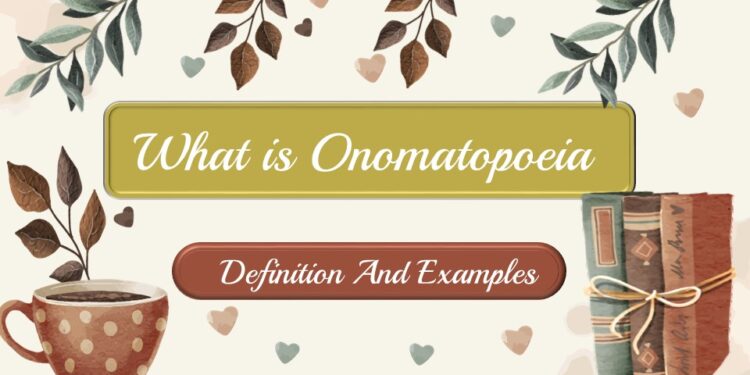What is Onomatopoeia Definition And Examples
Onomatopoeia is a literary device that refers to words that imitate or evoke the sounds associated with the objects or actions they describe. It is a linguistic technique used by writers to create vivid sensory experiences and enhance the reader’s understanding and engagement with the text. What is Onomatopoeia Definition And Examples Onomatopoeic words often mimic the natural sounds of animals, machinery, or environmental elements, allowing readers to mentally recreate or visualize the auditory experience.
Origins and Examples of Onomatopoeia: The term “onomatopoeia” comes from the Greek words “onoma” (name) and “poiein” (to make). What is Onomatopoeia Definition And Examples It refers to the process of making words that resemble the sounds they represent.
Also Read-
- What is Narrator Definition And Examples
- What is Motif Definition And Examples
- What is Mood Definition And Examples
Some common examples of onomatopoeic words include “buzz,” “hiss,” “crash,” “murmur,” “splash,” “sizzle,” and “bang.” These words directly imitate the sounds associated with bees, snakes, collisions, soft voices, water splashing, frying food, and loud noises, respectively.
Types of Onomatopoeia:
- Direct Onomatopoeia: This type of onomatopoeia involves words that closely resemble the actual sound they represent, such as “buzz,” “whisper,” or “clang.” What is Onomatopoeia Definition And Examples These words evoke a clear and direct association with specific sounds.
- Indirect Onomatopoeia: Indirect onomatopoeia refers to words that may not exactly mimic a particular sound but evoke a sense of the action or object they describe. What is Onomatopoeia Definition And Examples For example, words like “swish,” “flutter,” or “gurgle” convey the movement or characteristic sound associated with the action or object.
- Compound Onomatopoeia: Compound onomatopoeia involves combining multiple onomatopoeic words or sounds to create a specific effect. What is Onomatopoeia Definition And Examples For instance, “tick-tock” represents the sound of a clock, or “clip-clop” imitates the sound of a horse’s hooves.
Function and Effects of Onomatopoeia:
- Sensory Experience: Onomatopoeia enhances the sensory experience of a text by engaging the reader’s imagination and invoking specific sounds. It allows readers to vividly imagine and mentally hear the actions or objects described, adding depth and realism to the writing.
- Emotional Impact: Onomatopoeic words can create an emotional impact by associating specific sounds with particular emotions. What is Onomatopoeia Definition And Examples For example, the word “crash” can convey a sense of chaos or danger, while “whisper” can evoke a feeling of intimacy or secrecy.
- Immediacy and Intensity: By incorporating onomatopoeia, writers can convey a sense of immediacy and intensity in their descriptions. What is Onomatopoeia Definition And Examples The use of words that directly imitate sounds can make the narrative more dynamic and engaging, as readers feel immersed in the events unfolding.
- Sound Symbolism: Onomatopoeia can carry symbolic meaning, associating specific sounds with abstract concepts or thematic elements. What is Onomatopoeia Definition And Examples For instance, the repetition of the “s” sound in “hiss” or “whisper” can create a sense of secrecy or mystery, while the abrupt “cr” sound in “crash” can symbolize sudden disruption or impact.
Examples of Onomatopoeia:
- “The bees buzzed around the garden, collecting nectar from the blooming flowers.”
- “The fire crackled and popped, sending sparks dancing into the night sky.”
- “She sipped her hot soup, enjoying the slurping sound as she savored each spoonful.”
- “The thunder roared, shaking the windows with its powerful resonance.”
- “The rain pitter-pattered against the roof, creating a soothing lullaby.”
Conclusion
Onomatopoeia is a powerful literary device that brings language to life by imitating or evoking sounds associated with objects, actions, or phenomena. What is Onomatopoeia Definition And Examples Through the use of onomatopoeic words, writers can enhance the sensory experience of their readers, allowing them to mentally recreate or visualize the sounds being described. What is Onomatopoeia Definition And Examples Onomatopoeia adds depth, realism, and emotional impact to the text, engaging the reader’s imagination and creating a more immersive reading experience. What is Onomatopoeia Definition And Examples Whether through direct imitation, indirect suggestion, or compound combinations, onomatopoeia is a versatile tool that enriches language and enhances the writer’s ability to communicate and connect with their audience.
FAQ.
Q1: Can onomatopoeia be used in various forms of literature?
Ans: Yes, onomatopoeia can be used in various forms of literature, including poetry, prose, children’s books, and even scripts for plays or movies. It is a versatile device that can be applied to different genres and writing styles to enhance the sensory experience and create a more vivid and engaging narrative.
Q2: Are there specific rules or guidelines for using onomatopoeia?
Ans: There are no strict rules for using onomatopoeia. Writers have the creative freedom to incorporate onomatopoeic words as they see fit, considering the context, desired effect, and overall flow of the text. However, it is essential to use onomatopoeia judiciously and purposefully, ensuring that it adds value to the writing rather than becoming excessive or distracting.
Q3: Can onomatopoeia be used in languages other than English?
Ans: Yes, onomatopoeia exists in various languages around the world. Different languages may have their own onomatopoeic words that imitate the sounds of objects or actions. The effectiveness of onomatopoeia may vary across languages, but the concept of imitating sounds through words transcends linguistic boundaries.
Q4: Can onomatopoeia be used to convey emotions or moods?
Ans: Yes, onomatopoeia can be used to convey emotions or moods by associating specific sounds with particular feelings. For example, words like “crash” or “boom” can create a sense of excitement or intensity, while words like “whisper” or “sigh” can evoke a feeling of tranquility or melancholy. The choice of onomatopoeic words can contribute to the overall tone and atmosphere of a piece of writing.
Q5: Can onomatopoeia be used humorously?
Ans: Yes, onomatopoeia can be used to create humorous effects in writing. By using onomatopoeic words that exaggerate or caricature sounds, writers can create comedic moments or add a touch of whimsy to their work. The playful use of onomatopoeia can elicit laughter or amusement from readers, adding an element of entertainment to the text.
















